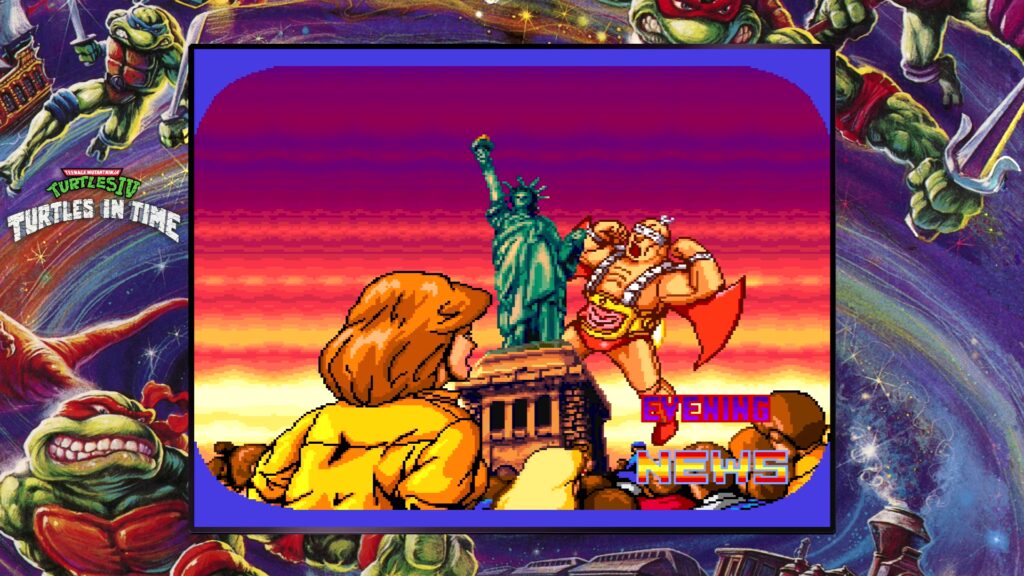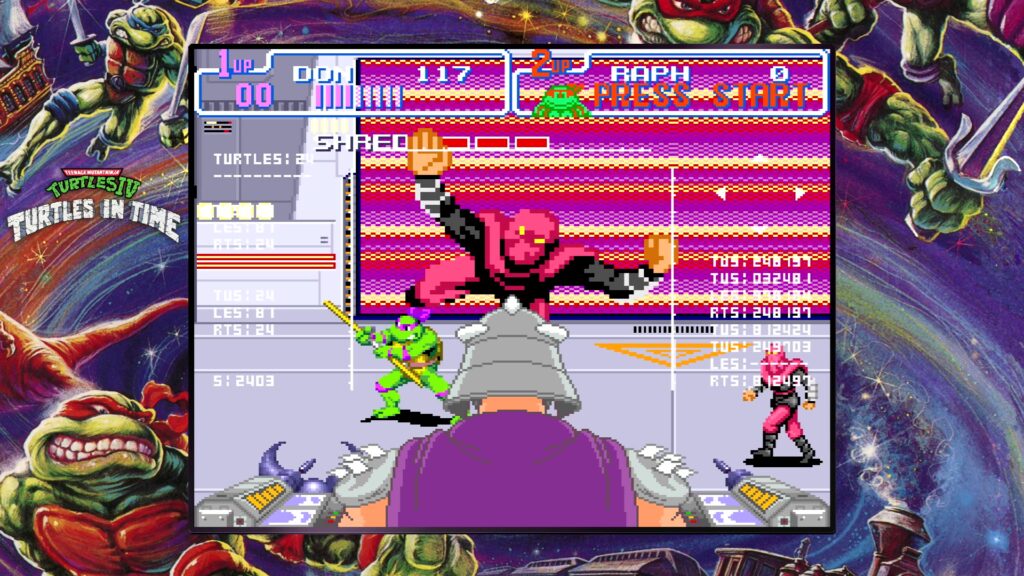Turtles in Time for SNES still beats the arcade version
The arcade version of Teenage Mutant Ninja Turtles: Turtles in Time is indeed, as we’ve already seen, a good game — particularly from a presentational perspective. But for quite some time, people have been saying that the SNES version, despite lacking the full four-player capability of the original arcade machine, is actually a better game.
Given that the NES version of the original Turtles game is, for my money, a better gameplay experience than the actual arcade machine, this is an entirely plausible argument, but I was still interested to compare and contrast for myself. And, indeed, in Teenage Mutant Ninja Turtles: The Cowabunga Collection, you can do just that.

The SNES port of Turtles in Time is known as Teenage Mutant Ninja Turtles IV: Turtles in Time, positioning it as a follow-up to Teenage Mutant Ninja Turtles III: The Manhattan Project. For many years, I must confess I thought that Turtles in Time was actually a SNES exclusive, because I don’t think I’ve ever seen the arcade machine in the wild, whereas the original Turtles game was all over the place.
It’s probably worth noting, however, that as someone from the UK, my views on this might be slightly skewed; arcades here weren’t anywhere near as widespread as they were in the States, since they mostly appeared in seaside towns rather than anywhere else. But even so, for the longest time, I felt like Turtles in Time had specifically been designed for console play. It just felt right on the SNES. And there’s a good reason for that, which we’ll come back to in a moment.
The setup for the SNES version of Turtles in Time is identical to the arcade original. Krang has stolen the Statue of Liberty — surely a step down from stealing the entire island of Manhattan in the previous game — and the Turtles set off to get it back, sick of the Foot Clan’s endless pointless bullshit that seems to have no other purpose than to piss them off.

The basic gameplay is the same, also: the Turtles can move in 8 directions around the screen, will run if you hold a direction for more than a moment, and various different moves can be unleashed with the use of a single attack button and the jump button.
Where things differ a bit is in the overall game structure. Rather than Shredder casting the Turtles into a time warp at the end of the Sewer Surfin’ level as in the arcade machine, the Sewer Surfin’ level is now reframed as a bonus round, providing the opportunity to earn significant score bonuses and perhaps extra lives (something which you couldn’t do in the arcade version) before leading into a brand new section in the Technodrome.
This whole new sequence features several stages of the Turtles battling through the Technodrome, culminating in a highly creative and unusual boss fight against Shredder. Rather than being a regular slugfest as the other bosses tend to be, here Shredder sits in a turret in the foreground of the screen, and can only be hit by grabbing and throwing Foot Clan soldiers “out” of the screen at him.

To go with this battle, the arcade version’s grapple and throw mechanics have been tweaked slightly; while in the arcade version, throwing a Foot Clan soldier out of the screen was a random occurrence when grappling a stunned enemy, here it can be performed deliberately. And once you master performing this move, it’s hard not to want to do it all the bloody time.
There are other new features in the SNES version, also. The most notable of these is that a side-scrolling futuristic “surfing” level later in the arcade original has been replaced with another bonus round, this time making use of the SNES’ Mode 7 quasi-3D capabilities for a much more exciting ride.
Overall, the game feels much more nicely balanced, too. Bosses in particular are much less likely to immediately smack you in the face the moment you get even vaguely near them, making it much more straightforward to hit them with a solid combo. There’s still plenty of challenge, though — robotic enemies are particularly dangerous to your health bar, for example, and continuing resets you back to the beginning of a stage (or a checkpoint in the case of longer stages such as the initial Technodrome visit) rather than allowing you to immediately pick up where you left off.

In other words, Turtles in Time for SNES isn’t just a straight arcade port — it’s been properly redesigned as a game for the home. Not only has it got new material to explore and enjoy, it’s also been rebalanced to make it more enjoyable and less cynical about wanting to extract cash from your pockets.
At the same time, its challenge factor has been paced in such a way that you likely won’t clear the whole thing using the available credits on your first attempt — though the Cowabunga Collection does provide some optional “Enhancements” to make the whole thing easier — and thus it has much more longevity.
Practically speaking, this is probably the optimal means of doing a home port of an arcade game if you’re not just going to emulate the arcade original. And, indeed, this was common practice during the 16-bit era, where most platforms for the home simply weren’t capable of emulating arcade machines. That was why arcades continued to thrive, after all — they provided experiences that it simply wasn’t possible to have in your living room.

These days, we’re a bit spoiled with compilations like the Cowabunga Collection as well as easy access to emulators like MAME providing us the ability to explore the vast library of arcade games at our leisure — exactly as they functioned in arcades, but without having to carry a roll of quarters in your pocket.
But in doing so, we lose an appreciation for the fine job that developers often did in bringing these games home to consoles and home computers. Turtles in Time is a shining example of that; despite being technologically inferior to the arcade hardware in some respects — notably, most of the digitised speech from the arcade original is absent here — the overall game experience is considerably better than the arcade machine, simply due to its rebalancing and restructuring.
It’s great to preserve the original arcade experiences as much as possible, of course — particularly with real arcades being a dying breed, and physical arcade machines often sadly ending up discarded and unloved — but Turtles in Time shows us that there’s still a great deal of value in a game originally designed for the arcade being significantly reimagined for its home release.
Teenage Mutant Ninja Turtles: The Cowabunga Collection is available now for PC via Steam, physically and digitally for Switch, physically and digitally for PS5, physically and digitally for PS4, and physically and digitally for Xbox One/Series blahdepoop.
Join The Discussion
Rice Digital Discord
Rice Digital Twitter
Rice Digital Facebook
Or write us a letter for the Rice Digital Friday Letters Page by clicking here!
Disclosure: Some links in this article may be affiliate links, which means we may earn a small commission if you make a purchase after clicking on them. This is at no additional cost to you and helps support Rice Digital!
- Letter from the Editor: passing the torch - June 30, 2023
- Super Woden GP 2 is looking promising - June 30, 2023
- Inti Creates is making a 32 bit-style Love Live action platformer - June 26, 2023







